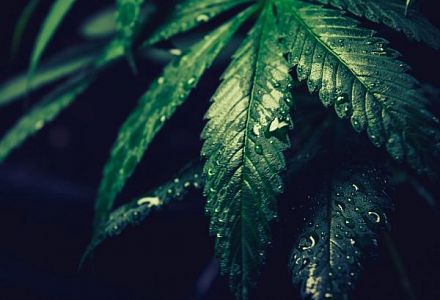It is impossible to talk about cannabis without mentioning cannabinoids.
Cannabinoids are chemical compounds responsible for many effects cannabis has on the human body.
The cannabinoids that are currently winning the popularity contest are CBD and THC. CBD (short for cannabidiol) has taken the wellness and beauty industry by storm. The potential beneficial properties of CBD on the human body can be enjoyed without worrying about intoxication.
This is in stark contrast to THC (short for tetrahydrocannabinol), a cannabinoid that not only has different properties but leads to intoxication after consumption.
While we still have a lot to learn about cannabinoids, both CBD and THC have already found their way into the pharmacological world. Both are currently used to make medication for specific illnesses in selected parts of the world.
Are there other cannabinoids in hemp?
Cannabis has over 120 cannabinoids we know of. CBG, CBC, and CBN are just a few that are getting some extra attention.
These cannabinoids are exclusive to the Cannabis sativa plant.
Are all cannabinoids the same?
Before we continue, it's important to mention that cannabinoids can be split into three distinctive subgroups:
-
Endocannabinoids - produced in the human body
-
Phytocannabinoids - produced in plants
-
Synthetic cannabinoids - created in labs
While these are three distinctive subgroups, they all have one thing in common. They are all capable of interacting with the endocannabinoid system in one way or another.
9 plants with cannabinoid-like compounds
Cannabinoids found in cannabis plants (including hemp) are unique to Cannabis sativa and can not be found in other plants. Yet, mother nature was generous enough to give us other plants that contain cannabinoid-like compounds, which are also capable of interacting with the endocannabinoid system. These are called cannabimimetic compounds, as they reflect (or mimic) the effects and structures of cannabinoids.
Here is a list of 9 plants that fit into that description, some of which are surprising!
Cacao
Raw cacao is a superfood, as it contains many beneficial ingredients found in high density. While cacao is known for its universally loved flavour, many do not know that it contains Anandamide.
Anandamide is an endocannabinoid produced naturally in the human body. It is believed to cause feelings of relaxation and bliss, slightly similar to the intoxicating effects of THC. This is why Andamamide is sometimes referred to as the natural THC for the body.
Some researchers think Andamamide is the reason behind cacao's power to make people feel good and "cosy".
Paracress (Jambú)
Paracress, also referred to as Jambú, is a plant native to South America and known for its complex and unique flavours.
Those who have tried it report that the flavour starts as slightly salty but quickly changes to a more strong and pungent. It can even cause a burning sensation in the mouth, which can lead to a feeling of numbness. This probably explains why our ancestors used this plant as a natural remedy to help cope with toothaches.
Besides the unique taste, Paracress contains Spilanthol - a cannabinoid-mimicking compound that has been shown to interact with the CB2 receptors of the human endocannabinoid system.
Liverworts
Liverworts are not just one type of species of plant. Instead, it's a group of plants containing PET (Perrottetinene). PET is a molecule that has been shown to have psychoactive effects, just like many cannabinoids do.
While next to no research has been done on the impact of Liverworts on the human body, anecdotal evidence suggests it might have effects similar to those of THC. Yes, we are talking about the well-known THC "high".
Because of the similarities between PET and THC, more research is encouraged to explore the possibilities of PET having potential medical benefits, maybe even better than THC! But, of course, only time will tell if that's indeed the case.
Echinacea
If you are interested in natural supplements and a healthy diet, you have probably heard of Echinacea. Echinacea is famous for its very high Vitamin C content and is often used by health enthusiasts as a supplement used to support the immune system.
Besides Vitamin C, Echinacea also contains N-alkylamides (NAAs). What's unique about NAAs is that while it is not a cannabinoid, they can interact with CB2 receptors of the endocannabinoid system, often found in immune cells.
Black Pepper
Are you surprised that the humble black pepper managed to get on our list? Well, you're not alone!
Many people don't expect that black pepper contains a significant amount of Beta-caryophyllene. Beta-caryophyllene is a terpene commonly found in many cannabis strains and is responsible for its peppery smell.
Additionally, some early research suggests that other compounds found in black pepper may have a calming and supporting effect on the endocannabinoid system. This is especially interesting for researchers looking for compounds that can help counteract some of the adverse effects of THC. So can black pepper be the answer?
Black Truffle
Did you know that cannabis and cacao are not the only plants capable of producing Anandamide? Black Truffle can do it too!
But before you go on a truffle hunt in your nearby forest, remember that these precious "black diamonds" are very different from traditional forest mushrooms.
If you want to start consuming truffles regularly, you need to get a well-trained truffle hunting pig or have deep pockets, as they can go for anything between 200 to 500 €/kg.
Kava
Kava is made from the root or stump of the Kava shrub (Piper methysticum). It is usually consumed as a drink but can also be made into pills, capsules or drops, and is known for causing intoxicating effects.
Enjoying Kava requires an acquired taste, so brace yourself for some intense flavours if you ever try it. You should also make sure not to drink too much at once, as its effects on an untrained body can be intense.
These effects are mostly linked to one specific compound called Yangonin. Yangonin has been shown to bind to CB1 receptors in the endocannabinoid system in the same way THC does. And just like in the case of THC, Yangonin can cause intoxication. In addition, Yangonin has also been shown to interact with CB2 receptors, but more subtly.
Hops
Have you ever had a beer and thought, "this smells like weed"?
That's because hops used to make beer come from the same family of plants as cannabis. That family is called Cannabaceae.
Even though the smell of hops and cannabis is very similar, it is impossible to get intoxicated from consuming hops alone. Fermentation is needed to create alcohol, which then leads to intoxication.
Hops and cannabis smell similar because they share many terpenes, such as myrcene, beta-pinene, and alpha-humble. While the exact role of terpenes in the human body is still not entirely known, the connection between hops and cannabis is undeniable.
Tea Shrubs (Camellia sinensis)
Drinking a cup of tea to relax is nothing new.
With many different types of tea available on the market, one type caught our attention. Camellia sinensis is a plant that produces buds that can be brewed into a hot tea beverage.
The reason why this tea is so unique is the fact that it contains Catechins, which are currently being researched for their potential.These properties result most likely from its ability to interact with the endocannabinoid system, just like compounds found in the cannabis plant.
What does it mean for a plant to contain cannabinoids?
While we primarily focus on how cannabinoids and cannabinoid-like compounds impact humans, it is essential to remember that mother nature did not develop these compounds for our pleasure.
Instead, many are there to protect the plant from natural elements or potential predators.
Fortunately, this does not mean we cannot enjoy the perks!




